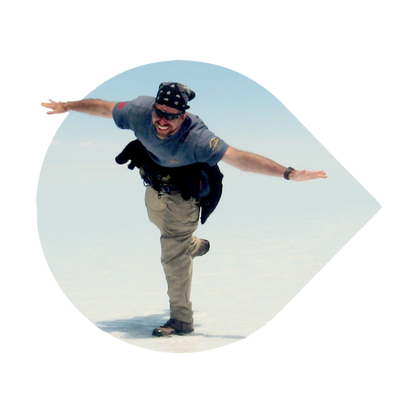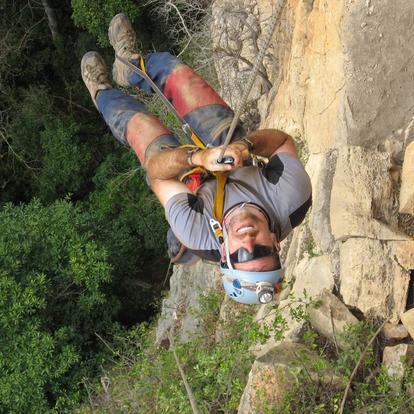The CGM Blog - Warrior Profile
How Dexcom Warrior Jadrino Huot Manages Diabetes While Travelling
Adventure travel aficionado Jadrino Huot believes that nothing is impossible. Jadrino has been an avid globetrotter since 1982 when his parents sent him on a cultural exchange school trip across Europe.
He was diagnosed with type 1 diabetes (T1D) the following year, but by then, he’d already caught the travel bug, and he wasn’t about to let his diagnosis stop him from seeing the world. Jadrino has been to 51 countries over the last four decades. He’s explored the most remote areas and climbed some of the world’s highest mountain peaks—all while managing diabetes.

“I want to inspire people, not just to travel the world, but to do something that they think they can’t do. I hope people see me and say, ‘If he can do it, why can’t I do it, too?’”
For Jadrino, resourcefulness and preparedness are the cornerstones of travelling with diabetes. Having completed many challenging trips successfully, he knows the ins and outs of managing blood sugar, through all types of travel, from beachside getaways to expeditions in extreme conditions. He’s proof that diabetes doesn’t have to hold you back from going after your dreams—even if they involve traversing the Himalayas or scuba diving in the Galapagos Islands. “I want to inspire people, not just to travel the world, but to do something that they think they can’t do,” Jadrino says. “I hope people see me and say, ‘If he can do it, why can’t I do it, too?’”
How Jadrino Travels the World with Confidence
Jadrino is no stranger to the things that could go wrong while travelling. He’s met the challenges of travel head-on by being ready for anything. Preparation and planning are vital when you’re going on any trip, whether you’re living with diabetes or not. With the right strategy, there’s a good chance you can go anywhere you want to. “I’ve been stuck in the desert, and I’ve camped overnight at 4,600 meters,” Jadrino says. “When you’re in those remote places, there are no convenience stores. You have to plan ahead and have solutions ready for any potential issues.” Here’s how Jadrino plans to manage diabetes on his international adventures.
Preparing Ahead of Time
Jadrino’s rule of thumb is to spend two or three times longer planning a trip than the length of the trip itself. It’s important for him to thoroughly research the area he’ll be visiting to understand what the conditions will be like and what resources will be available when he’s there. He always makes sure he has a plan for dealing with common travel challenges like delayed and cancelled flights.
Jadrino also researches the steps he might need to take if he needs to find a pharmacy or go to the hospital. He recommends using the International Association for Medical Assistance to Travellers (IAMAT) medical directory to find English-speaking doctors where you’re travelling. He also makes note of the generic names of the insulin and medications he’s using so that it’s easier for him to communicate with local pharmacists about what he needs, just in case. For example, you may use the brand name Lantus insulin, but its generic name is insulin glargine, and it is sold under different brands across the world.
It’s also a good idea to check whether pharmacies in the country you’re going to stock the brand of blood glucose meter (BGM) or continuous glucose monitoring device (CGM) you use in case something happens to the supplies you bring with you. It may also help local doctors to support you if you need to make an emergency visit. Jadrino previously used the Dexcom G6 and now uses the Dexcom G7 Continuous Glucose Monitoring (CGM) System.
To view a list of countries where Dexcom CGM is available and where to find more information for each, click here.

“When you’re in remote places, there are no convenience stores. You have to plan ahead and have solutions ready for any potential issues.”
Packing Proactively
Jadrino has a packing checklist for every trip he takes. In addition to the equipment he’ll need for the adventure, he includes more than enough insulin and snacks to treat lows, as well as important medical documents. In the past, Jadrino used a blood glucose meter to monitor his glucose while travelling, and he would pack more test strips than he thought he would actually use. He has used Dexcom G6 with the Dexcom receiver when travelling in the past, so he makes sure to pack the right electrical outlet adapters to ensure it’s charged.
Jadrino recommends packing all of your diabetes supplies in your carry-on luggage. It’s essential to be ready to manage your glucose even if your luggage is lost or you’re stuck in the terminal (or in the plane on the runway). It’s also a good idea to familiarize yourself with how to take your insulin and diabetes supplies through security at the airport.
To make it easier to communicate his condition to others in case of an emergency, Jadrino wears a diabetes medical ID bracelet and packs an extra one that can be worn in the water. He also carries a note translated into the local language that explains that he has diabetes and lists the diabetes supplies he has with him.
In the past, he hired someone at the local embassy to translate the note into the language of the country he was headed to. Now he uses online text translators.
Keeping Snacks Close at Hand
When you’re travelling, especially in remote locations, it’s vital to carry snacks with you wherever you go to help bring glucose levels up if needed. Jadrino uses energy gels—the kind marathon runners use—to help him treat hypos when he’s out on physically demanding expeditions. “I was in Costa Rica climbing one of the highest summits in Central America, Mount Chirripó, which is 3,821 meters,” Jadrino recalls. “We were far away from everything. I started to feel like I was going to faint; I was getting weaker. So I took an energy gel, and I was able to continue to the top.” In the years before energy gels became widely available, Jadrino would use tubes of cake icing for a quick boost of sugar.

Staying Mindful About New Foods
Exploring local cuisine is one of the highlights of any trip. However, it’s not always easy to tell what’s in a dish you’ve never eaten before, making it harder to dose insulin. Jadrino uses his Dexcom CGM to help guide him when he’s trying new foods. With the Dexcom G7, he can keep an eye on how a meal is affecting him in real-time and check-in regularly after eating to see if he needs to give himself more insulin.
Eating food in a different country can cause food poisoning or traveller’s diarrhea. Individuals living with diabetes are at higher risk of experiencing food poisoning. Food-related illnesses can cause dehydration and may lead to serious hypoglycemia, so it’s critical to have a backup plan for taking care of yourself. Avoid raw foods like unpeeled fresh fruits or salads and don’t drink water directly from the tap; don’t get ice in your drinks as it may have been made with tap water. Jadrino uses energy gels to get through bouts of food poisoning when he hasn’t been able to keep food or drinks down.
Adjusting Insulin Around Increased Activity and Jet Lag
Travelling takes you out of your everyday routines. It’s important to understand how factors like changing time zones and increasing your activity levels might affect your glucose levels and the way insulin works in your body.
Talk to your doctor about adjusting your mealtimes and insulin doses when you’re changing time zones. Jadrino prefers to keep the same schedule before he leaves and on the plane. Once he arrives, he’ll adjust his mealtime and insulin dosing schedule to the local time. “The key is to check your glucose levels more often,” he says. “Make sure you have snacks, insulin, or medication on hand to react to a high or a low quickly.”
It’s likely that your insulin needs will be different, depending on the nature of your trip. Keep in mind that sightseeing requires far more walking than you might be doing on an average day back home. The increase in physical activity can cause your glucose levels to drop, and intense exertion (such as hiking, swimming, or doing action sports) can impact your levels up to 24 hours after you’re done engaging in strenuous activity3.

“The key is to check your glucose levels more often. Make sure you have snacks, insulin, or medication on hand to react to a high or a low quickly.”
Choosing Technology that Works for Him
Jadrino prefers to use the Dexcom receiver rather than the Dexcom app on his smartphone when he travels. He finds that the receiver is small enough to securely tuck into a pocket when he’s climbing or hiking. Jadrino doesn’t always use his phone when he’s on a trip to avoid roaming fees. He can carry the receiver with him and leave his phone turned off somewhere safe. Using the receiver also gives him a little extra peace of mind: “I would rather have the receiver fall into an abyss than my phone—it’s much cheaper to replace the receiver than it is to replace my phone!”
Image: Dexcom Reciever + app screen
† Smart devices sold separately. For a list of compatible devices, please visit dexcom.com/compatibility.
† Smart devices sold separately. For a list of compatible devices, please visit dexcom.com/compatibility.
Setting Boundaries to Stay Healthy
“When I’m travelling, I'm not there to party or to go out at night,” Jadrino says. “I'm there to discover and to experience things.” Jadrino has a hard rule about bedtime when he travels to make sure he gets the most out of his trip, “I wake up with the sun, and I go to my room when the sun goes down.” This ensures that he’s in a safe place where he can get enough rest and access everything he needs to manage his glucose overnight. If you do choose to go out, Jadrino stresses the importance of not accepting any food or drink from someone you don’t know, which could have far more sugar in them than you think.
Inspiring Individuals Living with Diabetes to Take their Dream Trip
Over the years, Jadrino has found creative solutions to the challenges of living with diabetes so that he can live life the way he wants to. He’s adapted his diabetes management routine for adventure, allowing him to enjoy tough treks and diverse destinations all over the globe. His inspiring approach to living with diabetes has enabled him to have unique experiences that make his life richer and more meaningful. Jadrino believes that with planning and preparation, every individual living with diabetes can feel confident pursuing their travel dreams—whether it’s a multi-day hike through a rainforest, a tour of museums in Europe, or a road trip to another province.
† Smart devices sold separately. For a list of compatible devices, please visit dexcom.com/compatibility.
1 Insulin Glargine Injection. Cleveland Clinic. Accessed November 22, 2023. https://my.clevelandclinic.org/health/drugs/19802-insulin-glargine-injection
2 Evans E.W., et. al. Identifying Vulnerable Populations at Risk of Foodborne Infection: People with Diabetes Mellitus. Food Protection Trends. 2020;4(5):374-379. doi:10.4315/1541-9576-40.5.374
3 Food and Drink Considerations When Traveling. Centers for Disease Control and Prevention. Reviewed July 13, 2023. Accessed November 22, 2023. https://wwwnc.cdc.gov/travel/page/food-water-safety
4 Blood Sugar and Exercise. American Diabetes Association. Accessed November 22, 2023. https://www.diabetes.org/healthy-living/fitness/getting-started-safely/blood-glucose-and-exercise
1 Insulin Glargine Injection. Cleveland Clinic. Accessed November 22, 2023. https://my.clevelandclinic.org/health/drugs/19802-insulin-glargine-injection
2 Evans E.W., et. al. Identifying Vulnerable Populations at Risk of Foodborne Infection: People with Diabetes Mellitus. Food Protection Trends. 2020;4(5):374-379. doi:10.4315/1541-9576-40.5.374
3 Food and Drink Considerations When Traveling. Centers for Disease Control and Prevention. Reviewed July 13, 2023. Accessed November 22, 2023. https://wwwnc.cdc.gov/travel/page/food-water-safety
4 Blood Sugar and Exercise. American Diabetes Association. Accessed November 22, 2023. https://www.diabetes.org/healthy-living/fitness/getting-started-safely/blood-glucose-and-exercise
